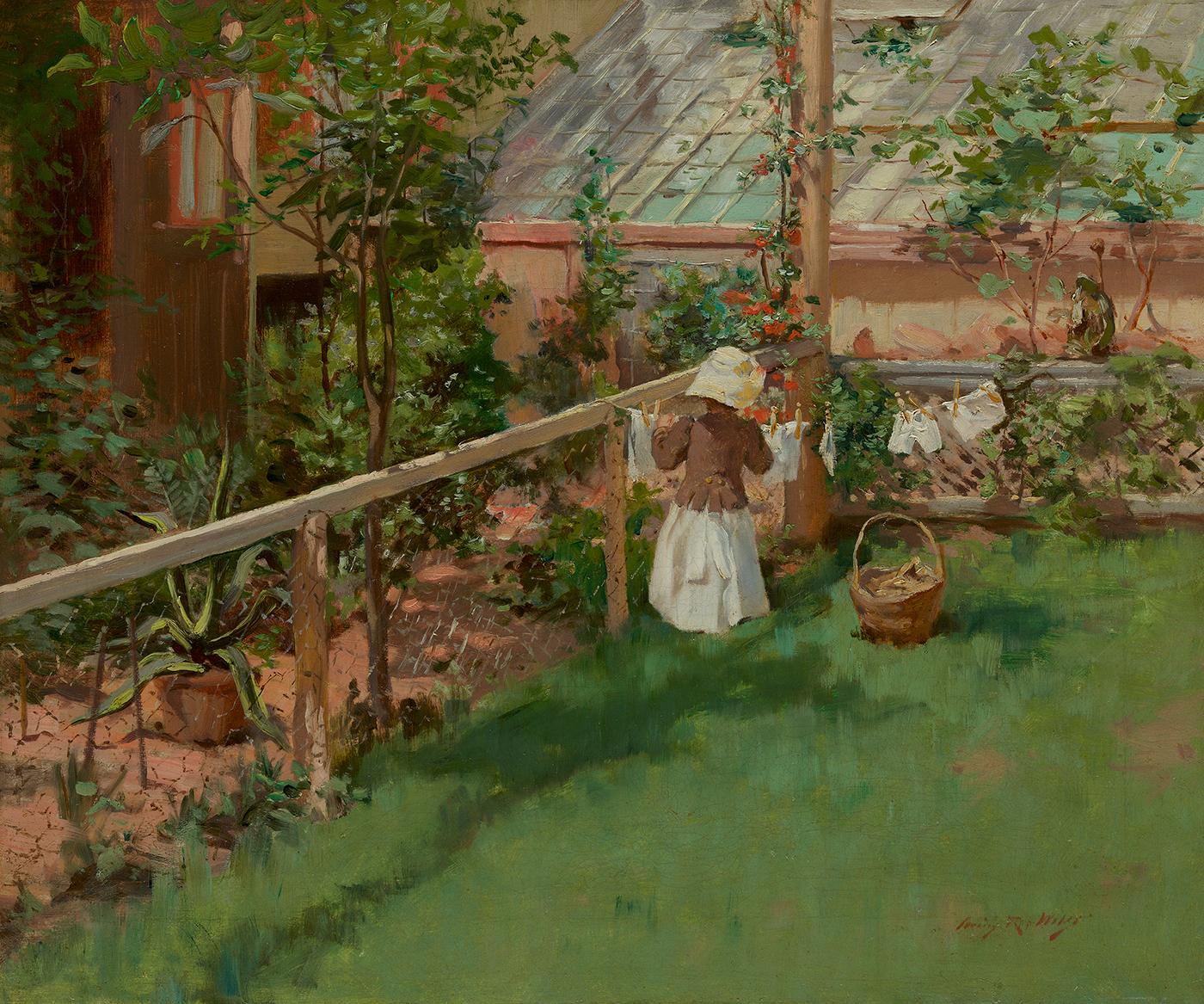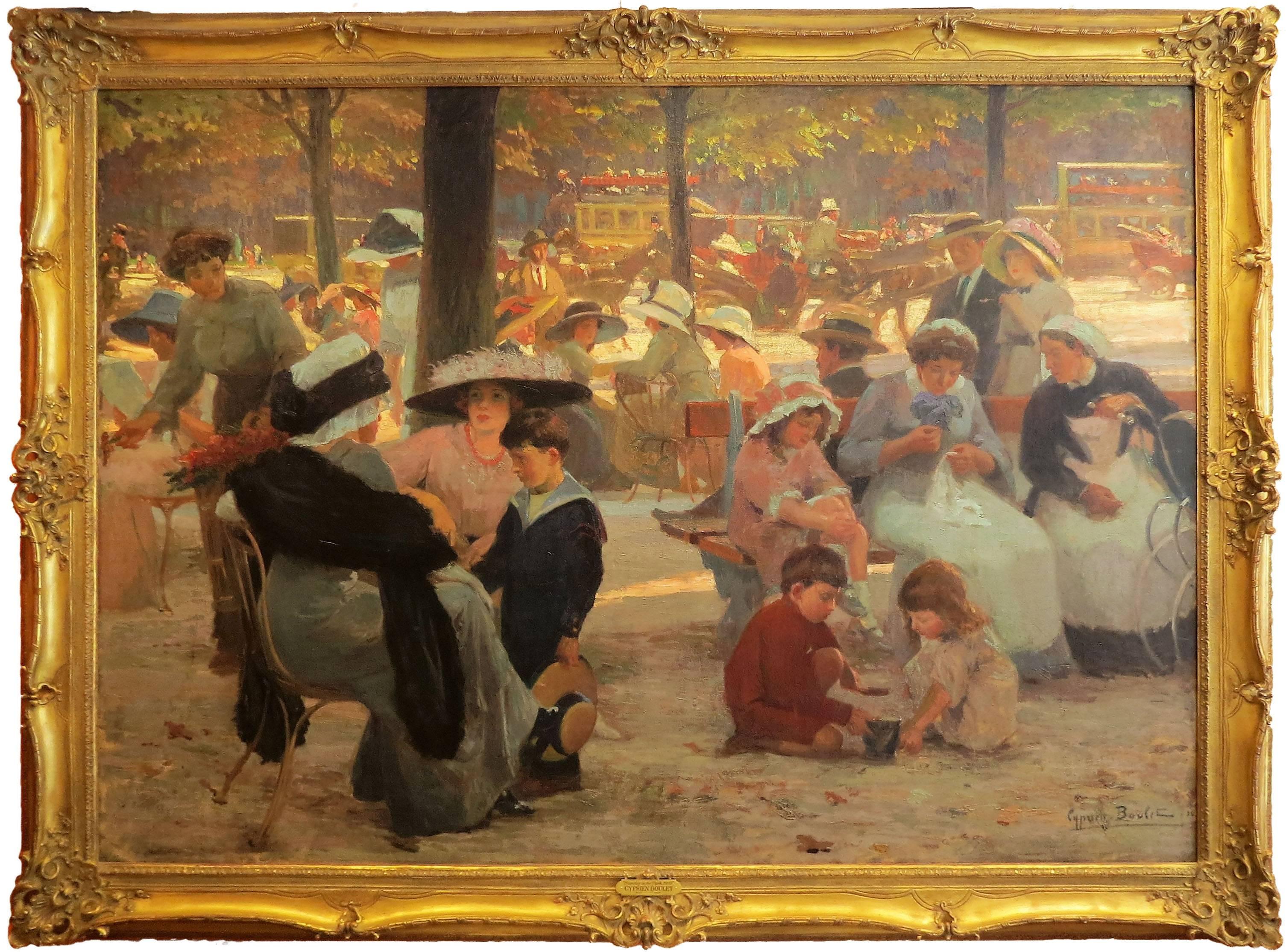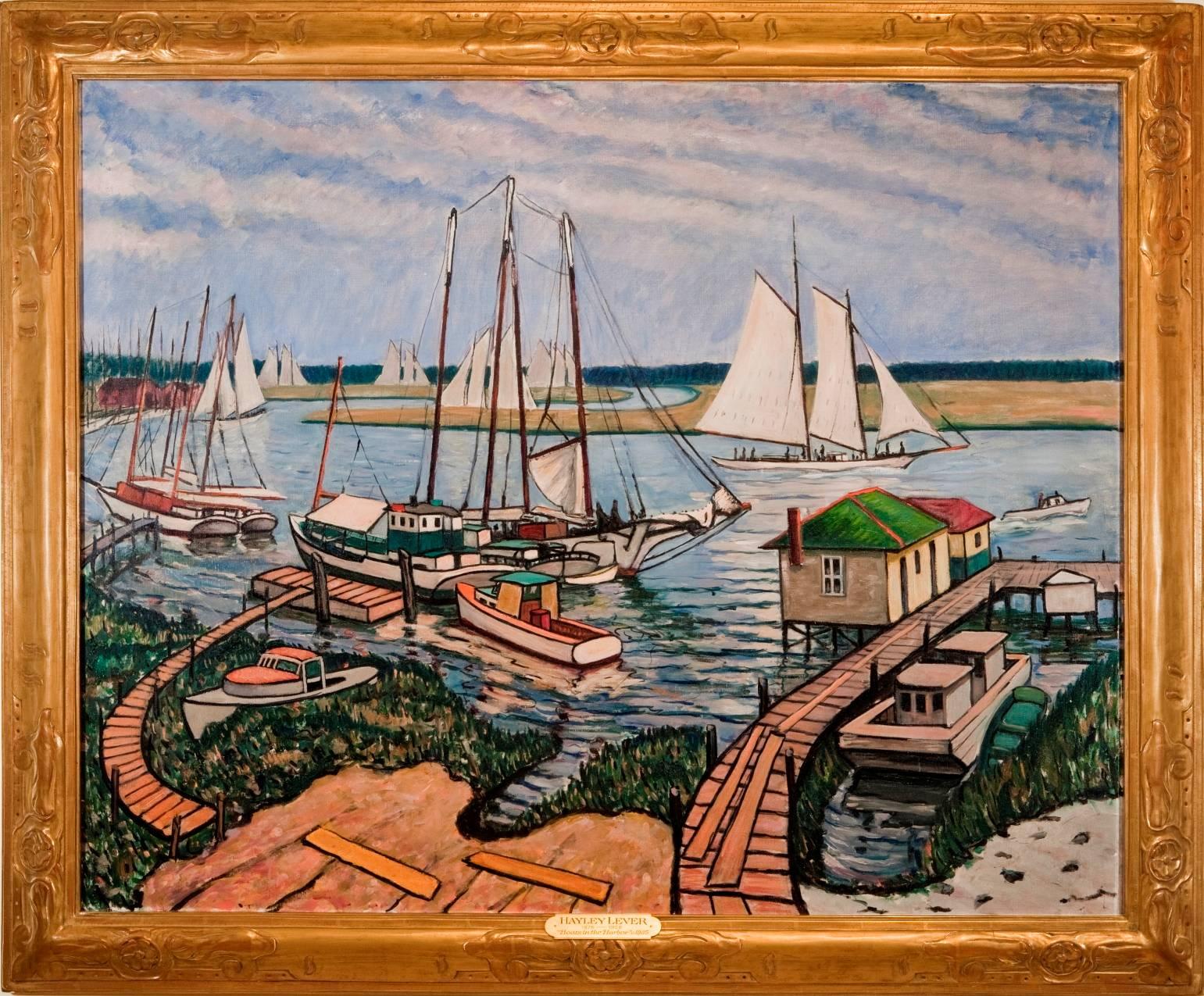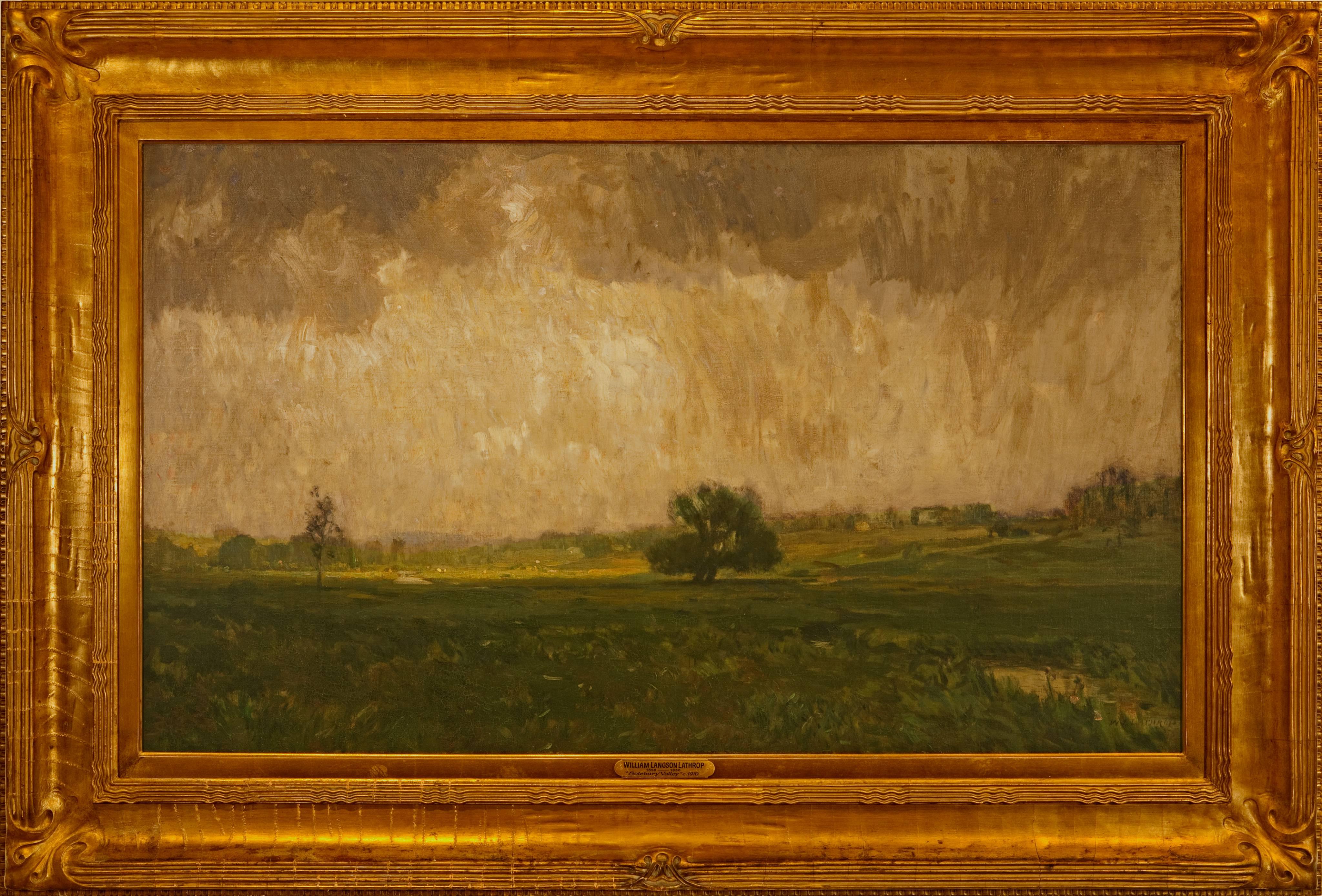Items Similar to Alfred Stevens, Brussels 1823 – 1906 Paris, Belgian, 'Clair de Lune sur la Mer'
Video Loading
Want more images or videos?
Request additional images or videos from the seller
1 of 12
Alfred StevensAlfred Stevens, Brussels 1823 – 1906 Paris, Belgian, 'Clair de Lune sur la Mer'1892
1892
About the Item
Stevens Alfred
Brussels 1823 – 1906 Paris
Belgian Painter
'Clair de Lune sur la Mer'
Signature: Signed lower right and dated 92
Medium: Oil on canvas
Dimensions: Image size 81 x 65 cm, frame size 97,50 x 81,50 cm
Provenance:
- Collection M. Klein, 1900 - Galerie Petit, Paris, 18 June 1926, nr. 22 - Private collection, Europe - De Vuyst, Belgium, 1998 - Galerie Kuppermans, Amsterdam - Private collection
- The Netherlands Exhibition - Exposition de l'oeuvre d'Alfred Stevens, Palais des Beaux Arts, Brussels, 1928
- Retrospective Alftred Stevens, Ecoile des Beaux Arts, Paris 1900, nr. 100
Literature:
- Alfred Stevens, Francois Boucger, Ed. Rieder Paris 1930, illustrated on page 36
- Documentation by Mrs Christiane Lefebre, 1998
Biography:
Alfred Émile Léopold Stevens (11 May 1823 – 24 August 1906) was a prominent Belgian painter renowned for his depictions of elegant modern women. His works, characterized by a realistic style and meticulous attention to detail, reveal the influence of 17th-century Dutch genre painting. While he initially gained attention for his social realist portrayal of the hardships faced by impoverished vagrants, he later achieved great critical and popular success with his portrayals of upper-middle class Parisian life. Notably, he often used the same models repeatedly, with some of them being identified in the infamous Book of the Courtesans, a confidential surveillance file maintained by the Paris vice squad, as noted by author Summer Brennan.
Stevens was born in Brussels, into a family deeply connected with the visual arts. His older brother Joseph (1816–1892) and his son Léopold (1866–1935) were both painters, while his other brother Arthur (1825–1899) was an art dealer and critic. His father, a veteran of the Napoleonic wars under the army of William I of the Netherlands, was an art collector with a notable collection of watercolors by Eugène Delacroix and other esteemed artists. Stevens’s upbringing was influenced by the environment of Café de l’Amitié, run by his maternal grandparents in Brussels, which served as a meeting place for prominent figures from the political, literary, and artistic spheres. Following the death of his father in 1837, Stevens left middle school to enroll at the Académie Royale des Beaux-Arts in Brussels. There, he came under the tutelage of François Navez, a Neo-Classical painter and former student of Jacques-Louis David, who was both the director of the academy and an old acquaintance of Stevens’s grandfather. Following a traditional curriculum, he initially drew from casts of classical sculptures and later transitioned to drawing from live models. In 1843, Stevens journeyed to Paris to join his already established brother, Joseph. He gained admission to the École des Beaux-Arts, the preeminent art school in Paris, although claims of him being a student of the director, Jean Auguste Dominique Ingres, are likely unfounded. One of his early works, The Pardon or Absolution (Hermitage, St. Petersburg), signed and dated 1849, showcased his mastery of a conventional naturalistic style influenced by 17th-century Dutch genre painting.
Stevens’s work was first publicly exhibited in 1851, when three of his paintings were featured at the Brussels Salon. He received a third-class medal at the Paris Salon in 1853, followed by a second-class medal at the Universal Exposition in Paris in 1855. His painting Ce qu’on appelle le vagabondage [What is called vagrancy] (Musée d’Orsay, Paris) garnered attention from Napoleon III, leading to a change in policy regarding the use of soldiers to remove the poor from the streets. Two other paintings displayed at the Salon in Antwerp in the same year, Chez soi or At Home and The Painter and his Model, introduced subjects from “la vie moderne” that became characteristic of his oeuvre: elegant young women dressed in contemporary fashion and artists in their studios. In 1857, Stevens made his first significant sale to a private collector when Consolation was purchased for a rumored 6,000 francs by the Berlin collector and dealer Ravéné. He and his brother also became part of the artistic milieu in Paris, frequenting salons hosted by Princess Mathilde and popular cafes, where they mingled with the likes of the Goncourt brothers, Théophile Gautier, and Alexandre Dumas. Stevens married Fanny Juliette Albertine Marie Hortense Blanc (1836-1891), a member of a wealthy Belgian family and a long-time acquaintance of the Stevens family, in 1858. The wedding was witnessed by the renowned painter Eugène Delacroix. The couple had four children: Leopold, Jean, Catherine, and Pierre. Stevens depicted his wife in numerous portraits, including Regrets and Memories. After her passing, he expressed enduring grief at her loss. During the 1860s, Stevens rose to considerable acclaim for his paintings of fashionable modern women.
His exhibits at the Salons in Paris and Brussels garnered favorable critical reception and attracted enthusiastic buyers. Notably, his work La Dame en Rose or Woman in Pink (Royal Museums of Fine Arts of Belgium, Brussels), completed in 1866, exemplified a blend of a stylishly attired woman in an interior setting with a detailed exploration of Japanese objects, reflecting his early enthusiasm for Japonisme. In 1863, he was awarded the Legion of Honor (Chevalier) by the French government. In 1867, he secured a first-class medal at the Universal Exposition in Paris, and his rank was elevated to Officer of the Legion of Honor. His social circle included prominent figures such as Édouard Manet, Edgar Degas, Charles Baudelaire, Berthe Morisot, James Abbott McNeill Whistler, Frédéric Bazille, and Puvis de Chavannes, and he was a regular patron of the Café Guerbois in Paris.
Stevens participated in the defense of Paris during the Franco-Prussian War but returned to Belgium with his family before the Paris Commune. They later returned to Paris, where Stevens continued to enjoy critical acclaim and success among collectors. In 1875, he purchased a grand house and garden on rue des Martyrs in Paris, which appeared in his paintings as well as those of other artists, such as Édouard Manet’s The Croquet Party. However, he was forced to vacate the property in 1880 to make way for the construction of a new street, which was eventually named after him. In 1878, he was appointed Commander of the Legion of Honor and was awarded another first-class medal at the Salon.
Despite earning a significant income from the sale of his paintings, Stevens faced financial difficulties during the 1880s due to a combination of poor investments and excessive spending. His financial strain was further compounded by the cost of summer trips to the seaside, which a doctor had advised him to take for health reasons in 1880. Consequently, when the Paris dealer Georges Petit offered him 50,000 francs to finance his vacations in exchange for paintings created during that period, Stevens agreed. This arrangement, spanning three years, resulted in the sea becoming a significant subject in his work, and over the course of his career, he produced numerous views of popular resorts along the Normandy coast and the Midi in the south. Many of these works were executed in a sketchy style influenced by the Impressionists.
Stevens also began teaching private students, including the renowned actress Sarah Bernhardt, who became a close friend, and the American artist William Merritt Chase. Other notable students included Berthe Art, Charles Bell Birch, Jules Cayron, Marie Collart-Henrotin, Louise De Hem, Harriet Campbell Foss, Georgette Meunier, Lilla Cabot Perry, Jean-Paul Sinibaldi, and Fernand Toussaint. The most significant work from the latter part of Stevens’s career was the monumental Panorama du Siècle, 1789–1889, which he painted in collaboration with Henri Gervex. In this project, Stevens painted the women and intricate details, while Gervex focused on the male figures, with the assistance of fifteen assistants. The painting garnered significant acclaim when it was exhibited at the International Exhibition in Paris in 1889.
Stevens received several notable tributes during his lifetime. In 1895, a large exhibition of his work was held in Brussels, followed by a retrospective exhibition at the Ecole des Beaux-Arts in Paris in 1900, marking the first retrospective dedicated to a living artist by the institution. Supported by patrons led by the Comtesse de Greffulhe, the exhibition achieved both social prestige and widespread acclaim. In 1905, Stevens was the only living artist featured in a retrospective exhibition of Belgian art in Brussels. Despite these accolades, he struggled to sell enough of his work to alleviate his financial difficulties. Having outlived his brothers and the majority of his friends, Stevens passed away in Paris in 1906, residing alone in modest accommodations while remaining in touch with his four children.
- Creator:Alfred Stevens (1823 - 1906)
- Creation Year:1892
- Dimensions:Height: 38.39 in (97.5 cm)Width: 32.09 in (81.5 cm)Depth: 3.94 in (10 cm)
- Medium:
- Movement & Style:
- Period:
- Condition:The artwork is elegantly displayed within a high-quality frame, impeccably preserved in its excellent condition. This piece is presented in a state suitable for immediate gallery hanging, having undergone professional cleaning and review.
- Gallery Location:Bruges, BE
- Reference Number:1stDibs: LU2006213599852
About the Seller
5.0
Vetted Seller
These experienced sellers undergo a comprehensive evaluation by our team of in-house experts.
Established in 1998
1stDibs seller since 2022
14 sales on 1stDibs
Typical response time: 8 hours
- ShippingRetrieving quote...Ships From: Bruges, Belgium
- Return PolicyA return for this item may be initiated within 14 days of delivery.
More From This SellerView All
- A Coastal View with Agave, Julien Stappers, Chenee 1875 – 1950, Belgian PainterLocated in Bruges, BEA Coastal View with Agave Stappers Julien Chenee 1875 – 1960 Belgian Painter Signature: Signed bottom right Medium: Oil on canvas Dimensions: Image size 33,50 x 42 cm, frame size 44 x 52,50 cm Biography: Stappers Julien was born in Chenee, Belgium in 1875. He was a painter of landscapes and town views but is most noted for his still life and florals and southern landscapes. Sunny colour palette and impressionist rendition. From 1894 – 1899, he was a student of De Vriendt...Category
Mid-20th Century Impressionist Landscape Paintings
MaterialsCanvas, Oil
- 'Swans of Bruges – Beguinage Bridge' Leo Mechelaere, Bruges 1880 – 1964 ErlangenLocated in Bruges, BELeo Mechelaere Bruges, Belgium 1880 – 1964 Erlangen, Germany Belgian Painter 'Swans of Bruges – Beguinage Bridge' Signature: Signed bottom left Medium: Oil on canvas Dimensions: Image size 65 x 75 cm Provenance: Painting "Swans of Bruges" was exhibited at Salon des Artistes Indépendants Normands in Rouen, France on June 7th, 1956. Biography: Leo Mechelaere, or Leon Mechelaere as he was sometimes known, emerged from the cobblestone streets of Bruges, Belgium, in 1880, destined to leave an indelible mark on the canvas of art history. Born into a world of rich cultural heritage and artistic inspiration, Mechelaere’s passion for painting ignited early, fueling a lifelong journey of creative exploration. His formative years were steeped in the traditions of the Academy of Fine Arts in Bruges, where he honed his craft under the tutelage of esteemed masters. Among them, Edouard Van Hove (1851 – 1913) and Franz Courtens (1850 – 1943) imparted their wisdom, guiding Mechelaere’s hand as he navigated the intricacies of form, light, and color. Under the mentorship of Juliaan De Vriendt...Category
Early 20th Century Impressionist Landscape Paintings
MaterialsCanvas, Oil
- Victor Gilsoul, Brussels 1867 – 1943, Belgian Painter, A View of Diksmuide, 1900By Victor GilsoulLocated in Bruges, BEGilsoul Victor Brussels 1867 – 1943 Belgian Painter A View of Diksmuide Signature: Signed bottom left, placed Dicsmuide and dated 1900 Medium: Oil on canvas Dimensions: Image size 55,50 x 71 cm, frame size 68,50 x 84 cm Biography: Gilsoul Victor Olivier was born in Brussels on September 10, in 1867. He was a Belgian impressionist painter of landscapes, marines, harbour scenes, architectures, interiors, city and canal views, portraits and figures. He was also a watercolourist. Gilsoul studied at the Antwerp Academy of Fine Arts with the famed master teachers and artists François Courtens (1854 – 1895) and Louis Artan (1837 – 1890). In 1882 he won his first prize at the Academy and in 1884 debuted at the Brussels Salon. He studied also at the Brussels Academy of Fine Arts, where he won a prize (1885-1890). Gilsoul was member of the group ‘Voorwaerts’ in 1891. He was awarded a silver medal at the Paris World Fair in 1900. In the same year, King Leopold II commissioned several compositions for his yacht “Alberta” and knighted him to the Order of King of the Belgians. The painter stayed from 1911 in Paris, where he often painted the Versailles region, also worked and lived for some time in Brittany. He had several exhibitions in France. He was a teacher at the Antwerp Higher Institute of Fine Arts (1924-1930) and a member and honorary member of La Gravure Originale Belge (1928). Gilsoul painted at the Belgian coast...Category
19th Century Impressionist Landscape Paintings
MaterialsCanvas, Oil
- A Little Farmhouse, Georges De Sloovere, Bruges 1873 – 1970, Belgian PainterLocated in Bruges, BEA Little Farmhouse De Sloovere Georges Bruges 1873 – 1970 Belgian Painter Bruges School Signature: Signed bottom left Dimensions: Image size 71 x 60 cm, frame size 81 x 70 cm Mediu...Category
Early 20th Century Impressionist Landscape Paintings
MaterialsCanvas, Oil
- A Summer’s Day, Cornelis Koppenol, Zoetemeer 1865 – 1946 The Hague, SignedLocated in Bruges, BEA Summer’s Day Cornelis Koppenol Zoetemeer 1865 – 1946 The Hague Dutch Painter Signature: Signed bottom left Medium: Oil on canvas Dimensions: Image size 29 x 43 cm, frame size 37 x 52 cm Biography: Koppenol Cornelis was born on December 26 in 1865 in Zoetmeer, The Netherlands. He was a Dutch painter of genre scenes, portraits, still lifes, flowers, beach scenes with figures, cows and sheep markets, landscapes with farm workers, farm interiors. He is known especially for paintings with farm girls with geese...Category
Early 20th Century Impressionist Animal Paintings
MaterialsCanvas, Oil
- A Pair of Swans, Leonie Arden, Antwerp 1859 – 1904 Brussels, Belgian, SignedLocated in Bruges, BEA Pair of Swans Leonie Arden Antwerp 1859 – 1904 Brussels, Belgian Painter Signature: Signed bottom right Medium: Oil on canvas Dimensions: Image size 21,5 x 27 cm, frame size 28 x...Category
19th Century Impressionist Animal Paintings
MaterialsCanvas, Oil
You May Also Like
- At the ClotheslineBy Irving Ramsey WilesLocated in New York, NYSigned lower right: Irving R. WilesCategory
Late 19th Century American Impressionist Landscape Paintings
MaterialsCanvas, Oil
- "Sunday in the Park, 1910"By Cyprien Eugène BouletLocated in Lambertville, NJSigned Lower Right Cyprien-Eugène Boulet (1877 - 1927)Category
Early 20th Century Impressionist Landscape Paintings
MaterialsCanvas, Oil
- "Boats in the Harbor"By Hayley LeverLocated in Lambertville, NJOriginal Period Frame Hayley Lever (1876 - 1958) Hayley Lever's exceptional career path took him from the shores of his native Australia to those of England, and then the United S...Category
1930s Impressionist Landscape Paintings
MaterialsCanvas, Oil
- "Alley Fiends"By John R. GrabachLocated in Lambertville, NJJim’s of Lambertville is proud to offer this artwork by: John R. Grabach (1886 - 1981) John Grabach was a highly regarded New Jersey artist, teacher, and author of the classic text...Category
1930s American Impressionist Landscape Paintings
MaterialsCanvas, Oil
- "Forest Strongholds"By John F. CarlsonLocated in Lambertville, NJSigned lower right. Complemented by a hand carved and gilt frame. Exhibited at the National Academy of Design, 1928Category
20th Century American Impressionist Landscape Paintings
MaterialsCanvas, Oil
- "Solebury Valley"By William Langson LathropLocated in Lambertville, NJSigned lower right. Complemented by a period frame. William L. Lathrop (1859-1938) Deemed “Father of the New Hope Art Colony”, William Langson Lathrop was born in Warren, Illinois. He was largely self-taught, having only studied briefly with William Merritt Chase in 1887, at the Art Students League. Lathrop first moved east in the early 1880s, and took a job at the Photoengraving Company in New York City. While there, he befriended a fellow employee, Henry B. Snell. The two men became lifelong friends and ultimately, both would be considered central figures among the New Hope Art Colony. Lathrop's early years as an artist were ones of continuing struggle. His efforts to break through in the New York art scene seemed futile, so he scraped enough money together to travel to Europe with Henry Snell in1888. There he met and married an English girl, Annie Burt. Upon returning to New York, he tried his hand at etching, making tools from old saw blades...Category
1910s American Impressionist Landscape Paintings
MaterialsCanvas, Oil





